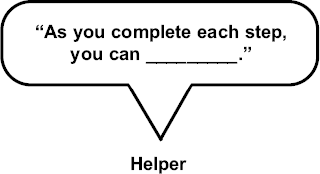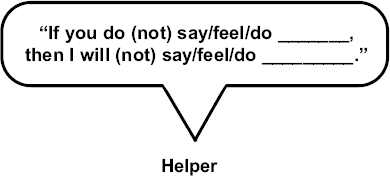The next step in initiating involves developing reinforcements that will encourage the helpees to take the needed steps. Reinforcements are simply things that matter to us. They are most effective when they are applied immediately following the performance of a step.
The consequences of carrying out the steps to achieve goals and overcome deficits are often too distant for the helpees. More immediate reinforcements must be introduced.
Clearly, these reinforcements must come from the helpee’s frame of reference. What we think matters for the helpees must really matter to them. Many helping programs have failed because of their inability to attach appropriate reinforcements. In this context, we continue to emphasize our responsiveness: empathy is the source of all knowledge about powerful reinforcements for the helpees. Sometimes, it may be appropriate for helpees to work with support persons or support groups to monitor their performance and to administer the reinforcements.

DEVELOPING REINFORCEMENTS
Positive reinforcements or rewards are our most potent reinforcements. People tend to work hard for things that really matter to them. This means the helper must work diligently to develop the positive reinforcements from the helpee’s frame of reference. In turn, the helpee must work diligently to receive the reinforcements.
Our helpee, for example, might decide simply that he would go out with his friends on Friday and Saturday nights as he successfully completed each step of his program. We can develop similar reinforcements for any program. The reinforcements will vary as widely as human nature itself.

REINFORCING POSITIVELY
To the degree we can, we want to avoid employing negative reinforcements. We use the term in a restricted sense to mean punishments. In this context, the application of negative reinforcements stimulates other reactions, such as aversive reactions to the person who administers the punishment. Initially, we should attempt to define the negative reinforcements as the absence of rewards.
In our helpee’s case, he defined his own negative reinforcements as the absence of rewards. Specifically, he decided to stay home on the weekend to work on the uncompleted step in his program. Again, similar negative reinforcements may be designed and applied in other programs. Like rewards, negative reinforcements vary widely, and to use them effectively, we must be finely tuned to the people involved.

REINFORCING NEGATIVELY
If it is unclear whether a step was performed in a satisfactory manner, then we must vigilantly observe the performers. We do so to determine whether the helpees are moving toward or away from the goals. Ultimately, all behavior is either goal-directed or not goal-directed.
Once we come to understand the helpees’ behaviors we respond to positively reinforce the goal-directed behavior of our helpees and to negatively reinforce the negative, goalless behavior. We are aligning ourselves with what is healthy in the individuals and opposing that which is unhealthy. We communicate our respect for them as people, but not for their unhealthy behavior. We may use ourselves as potent reinforcers by being conditional. We can do this by spelling out the implications of the helpee’s behavior for our own behavior.

OBSERVING VIGILANTLY AND REINFORCING CONDITIONALLY
